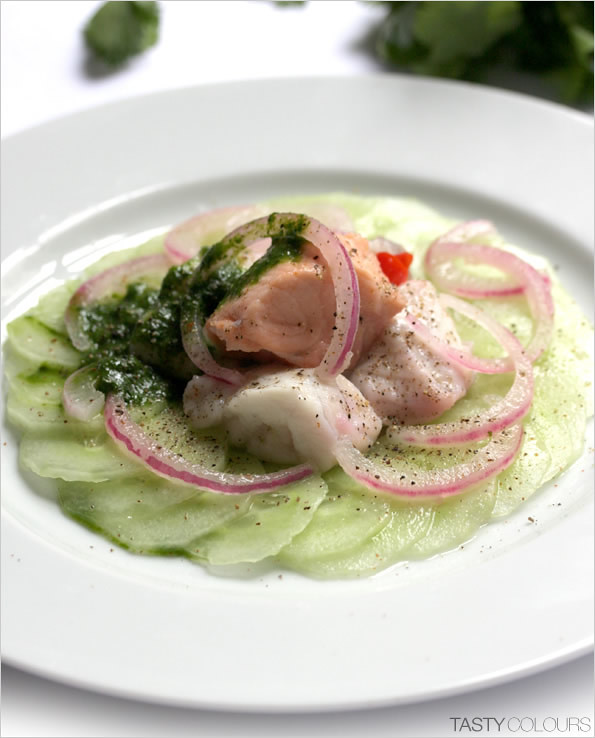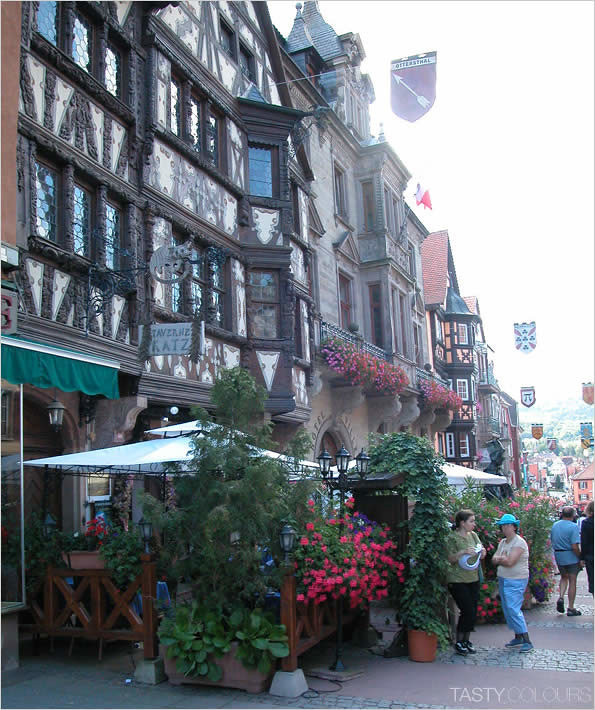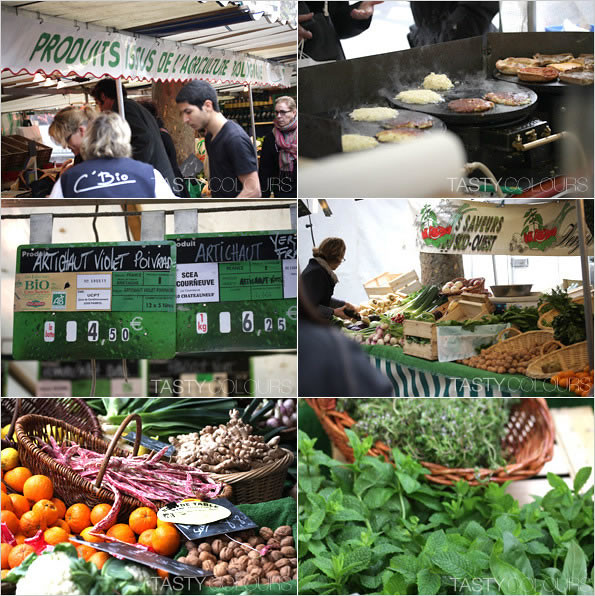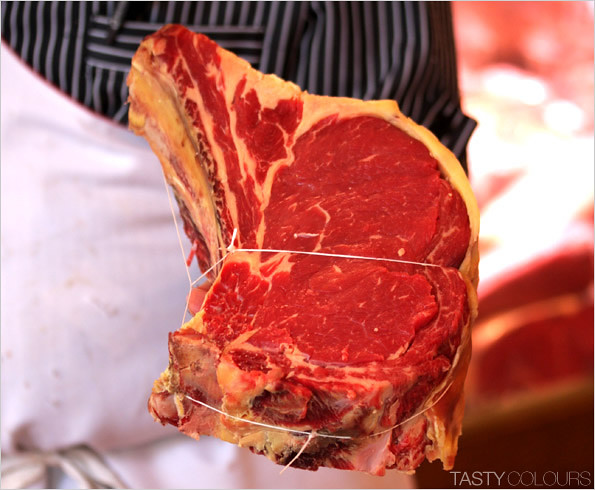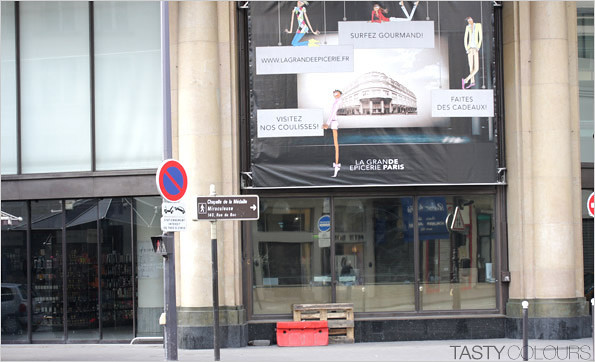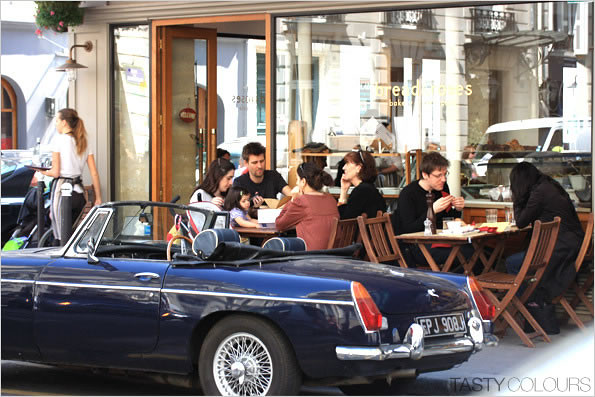I am very busy here in Kraków as I am involved into some new projects. I do not have any spare time for cooking. I hope that it will change soon. Not only I want to invite you to read my interview with Mr Bajon (the translation is not finished), but I am going to work on new recipes using seasonal and regional products. I am also going to take a few trips around my region, Małopolska and other regions of Poland as well, to search for old and local specialties and producers. I am not even mentioning my participation to culinary workshops about Jewish cuisine, organized during the International Festival of Jewish Culture in Krakow, which has just started. There are also other foodie events here during the summer, most of them designated to the promotion of small producers of regional products. I am going to visit those places, take pictures of people, food and places.
Today’s dish is far away from Central European traditions. I made this variation on Ceviche several weeks ago, when my husband was in Warszawa. It is an extra refreshing starter or main dish for a hot summertime. I was hesitating to present it today, because again, the weather here in Kraków is far away not only from the tropics but from summertime in general. I should rather present Polish warming up barley soup, rich and savory Bigos or at least Aligot from Auvergne - my favorite region in France, except for Provence. But, at least theoretically there is a calendar summer. Perhaps in some places where some of you live, one suffers from sweltering heat and would enjoy having a few bites of this low fat and rich in proteins citrus-marinated seafood? I do not know about you, but except for fish tartar and sashimi it is one of my favorite seafood starters. Usually, during the week, I make a simplified and quick version of it with shrimps, which I marinade for a short time.
This time I “cooked” my fish for five hours. Despite the fact that the marinade is extremely acid, the fish, which changes its texture and color (like if it was cooked) keeps the flavor of the sea. Some advise a shorter “cooking” time – depending on the type of fish. I have never checked how much time a particular fish needs for “cooking”. Anyway, I was checking my fish, trying it every hour, and in my opinion, one or two hours for that size of cubes I cut the fish into, was not enough. However, we all have our preferences and the "cooking" time should be set accordingly.
I “cooked” the fish in quite a large amount of lime and lemon juice (the juice should cover the fish completely). As I mentioned it, the marinade itself is very acid, and in Peru it is served as a drink called "Tiger Milk". For me, it is too acid and I threw it away. I also prepared on the side a simple dressing with the addition of some palm sugar, to balance the taste. You can experiment with other dressings, like for example this one that Cristina prepared, which I discovered just a few days ago. Check her recipe for dressing ; it sounds very appealing and I will definitely try it when I am back in Paris
I served it with cucumbers. You can add avocado (this is how I usually make the shrimp “Ceviche”) and cherry tomatoes or tomatoes. If you want to serve it as a full meal, add some tortilla chips on the side or some rice, or even potatoes. As regards herbs – feel free to experiment and use your favorite: chives, basil, scallions, mint or parsley (I used coriander like in the classical version).
Serves 4
Ingredients:
200 g salmon, cut into 2-3 cm cubes (you can use any other sea fish, shells or shrimps)
200 g cod loin cut into 2-3 cm cubes
1 medium red onion, peeled, washed and cut into thin slices
3 limes
3 lemons
1 cucumber (around 300 g)
1-2 handfuls of coriander, finely chopped
5-6 tablespoons olive oil (or as much as you want)
1 small red chili pepper, finely chopped (if you are tempted to have your Ceviche spicier, feel free to add as much as you can stand)
1 tablespoon palm sugar
Salt
Preparation:
Place the cubes of fish in a medium size bowl.
Cut lime and lemons into halves (wash them firstly, of course) and squeeze their juice. Pour the juice on the fish (it should be covered). Add onions and chili, mix well. Cover the bowl with a plastic film and place it into the fridge for a few hours.
Once the fish is cooked, strain the juice. If you want to serve the marinade as Tiger Milk in small glasses, keep it. Or simply throw it away.
Peel cucumber and cut it into very thin slices.
In a mortar, mash coriander with some olive oil and sugar (if you do not have a mortar, simply mix those ingredients thorough fully). Add a bit of salt, to taste. You can add a tiny bit of sesame oil, too, if you like it.
Place the cucumber onto a plate then lay the cubes of fish with onion and chili. Pour the coriander dressing on top.
I did not add any accompaniment to this dish (as I wanted to enjoy the taste of the fish), but it will go deliciously of course with some cherry tomatoes cut into halves, avocado, rice and so on…
And at the end I present my 10th picture stored in my PC. Just before leaving Paris I was invited by Lidka to a bloggers’ play (nobody knows what it is about except for a fact that you should present the 10th picture from you computer).
So here it is – made in summer 2005, probably in Colmar, in Alsace, but I am not quite sure.
Now I invite Karolina.

